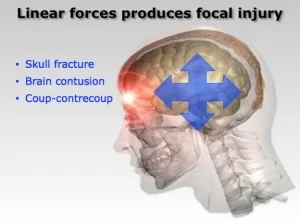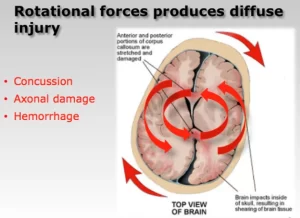To consider whether a motorcycle helmet might reduce the risk of brain trauma in a motorcycle accident it is first important to understand the two primary mechanisms associated with traumatic brain injury – impact loading and impulse loading, according to motorcycle helmet expert, Dr. John Lloyd.
 Impact loading involves a direct blow transmitted primarily through the center of mass of the head, resulting in extracranial focal injuries, such as contusions, lacerations and external hematomas, as well as skull fractures. Shock waves from blunt force trauma may also cause underlying focal brain injuries, such as cerebral contusions, subarachnoid hematomas and intracerebral hemorrhages.
Impact loading involves a direct blow transmitted primarily through the center of mass of the head, resulting in extracranial focal injuries, such as contusions, lacerations and external hematomas, as well as skull fractures. Shock waves from blunt force trauma may also cause underlying focal brain injuries, such as cerebral contusions, subarachnoid hematomas and intracerebral hemorrhages.

Whereas, impulse or inertial loading caused by sudden movement of the brain relative to the skull, produces cerebral concussion. Inertial loading at the surface of the brain can cause subdural hemorrhage due to bridging vein rupture, whereas if affecting the neural structures deeper within the brain can produce diffuse axonal injury (DAI).
Epidemiology Studies
Two major epidemiologic studies into the causation of motorcycle accidents have been conducted in North America and Europe: the Hurt Report and the MAIDS report. The Hurt Report showed that failure of motorists to detect and recognize motorcycles in traffic is the predominating cause of motorcycle accidents. Seventy-five percent of accidents were found to involve a motorcycle and a passenger vehicle, while the remaining 25% of accidents were single motorcycle accidents. Two-thirds of motorcycle-car crashes occurred when the car driver failed to see the approaching motorcycle and violated the rider’s right-of-way. Findings indicate that severity of injury increases with speed, alcohol motorcycle size and speed.
The MAIDS study (Motorcycle Accidents In Depth Study) is the most recent epidemiologic study of accidents involving motorcycles, scooters and mopeds, which was conducted in 1999 to investigate motorcycle accident exposure data across five European countries. Key findings show that passenger cars were the most frequent collision partner (60%), where 69% of the drivers report that they did not see the motorcycle and the predominance of motorcycle accidents (54.3%) occurred at an intersection.
In 1995, the European Commission Directorate General for Energy and Transport initiated a Cooperative Scientific and Technical Research (COST) program to investigate Motorcycle Safety Helmets. Several agencies from Finland, the United Kingdom, France and Germany participated in this study, which compiled and analyzed data from 4,700 motorcycle fatalities in Europe, each year. The COST report documents that 75% of all fatal motorcycle accidents involve head injury. Linear forces were present in only 31% of fatal head injuries, while rotational forces were found to be the primary cause in over 60% of cases. Within the scope of this study experiments were performed using drop tests with accelerometers to measure linear and rotational accelerations of the brain and skull mass associated with different types of impacts. These tests confirmed rotational acceleration to be a primary cause of brain injury in helmeted motorcycle accidents.
While the motorcycle helmet is currently the most effective means of protection for riders, data suggests that motorcycle helmets are only 37-42% effective in preventing fatal injury. By reducing the effects of blunt trauma to the head it is generally believed that risk of brain injury, including concussion, axonal injury and hematoma would also be reduced. However, the mechanisms of head and brain injury are very different. New research shows that these mechanisms are poorly coupled, contrary to previous beliefs.
Summary
- Motorcycle helmet expert report that rotational forces acting on the brain are the underlying cause of traumatic brain injuries.
- Motorcycle helmets, including those certified under DOT and SNELL standards are designed to mitigate forces associated with linear acceleration.
- According to motorcycle helmet expert, helmets are not currently certified under either DOT or SNELL standard against their ability to protect against the angular / rotational forces.
- Epidemiologic evidence from the COST-327 report indicates that motorcycle helmets do not provide adequate protection against closed head and brain injuries
New Research
Motorcycle helmet expert Dr. John Lloyd recently published a new study: Biomechanics of Motorcycle Helmets: Protection Against Head and Brain Injury. Testing proves that motorcycle helmets provide inadequate protection against concussion and severe traumatic brain injury associated with even relatively minor head impact
